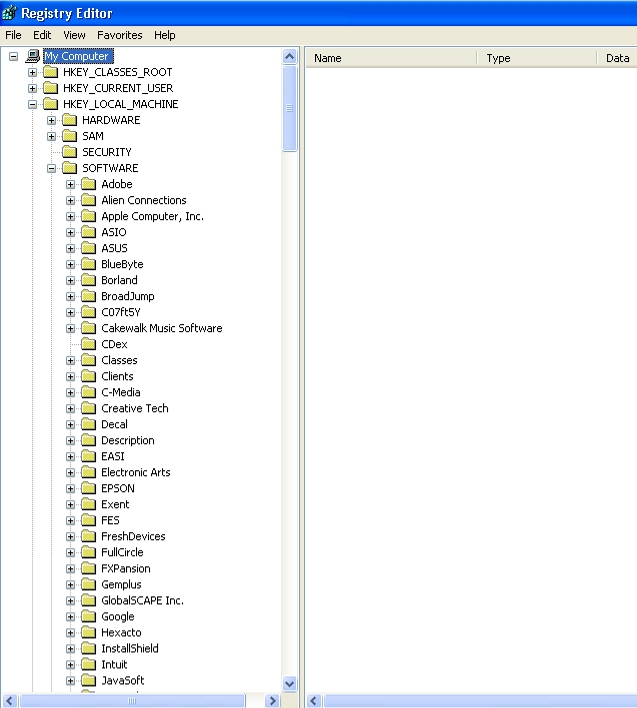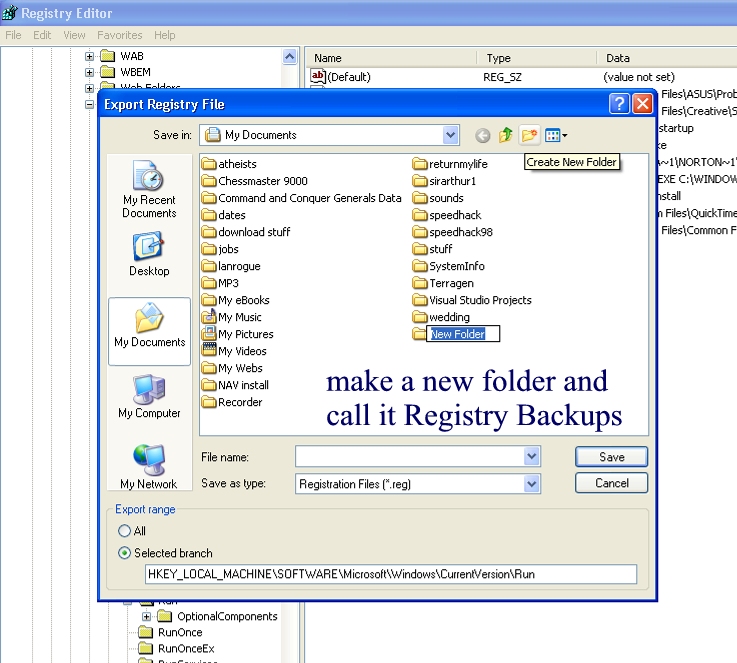FOR XP USERS: In the last step, we
disabled all the stuff we weren't sure of.
Now that you rebooted your computer, use it
for a while. Use it for an hour or
two, maybe even a day or two. Does
everything work ok? Is your anti-virus
running properly? Does word, internet,
and email still work? If something is
broken, go back to msconfig
(START-->RUN type 'msconfig' press enter).
One at a time, recheck a box and reboot.
Identify the box(es) that are needed for
your computer to run the way you want, and
uncheck everything else. Once your
computer works properly, its time to write
down everything that is unchecked.
Launch MSCONFIG. Click the Startup
tab.
Write down the name of the
startup item of each line that is uchecked.
Then click the Services Tab, check the box
at the bottom that says "Hide All Microsoft
Services". Again,
Write down the name of the
service of each line that is uchecked (we
will use this list in Phase 4).
We will now delete those items from the
registry.
AND NOW WE WILL CLEAN THE REGISTRY, WHERE WE
CAN GAIN SIGNIFICANT SYSTEM PERFORMANCE.
99% of all computer owners do not know how
to use the registry. Programmers know
this. Many pernicious programs like Real
Player, Gator, Bonzai Buddy, ICQ, and
QuickTime make it hard…very hard…for you to
stop them from starting up automatically.
They may not be listed in your Startup
folder, yet still they start everytime you
boot up your computer! This is because
there is a special place in your registry
that contains a list of programs that will
start automatically, even though they are
not listed in your startup folder. This
“secret place” is where you will find
Trojans, Viruses, Spyware, and persistently
obnoxious programs that like to activate
themselves whether you like it or not. Of
course, all these programs will slow down
your computer to a creeping crawl. Most
people do not know where or how to modify
this list of programs, therefore they simply
suffer through the computer muck day after
day wondering what happened to their
high-powered computer they once had.
MSCONFIG, for you XP users, is simply a
program that 'reads' the registry.
With MSCONFIG you can disable something, but
you cant delete it. We need to delete
the crap, and the only way to do that is
with the registry.
WARNING!
If the CPU is the
“brains” of the computer, your registry is
the DNA of your computer. Follow my
instructions very carefully. If you alter
your registry wrongly, you could completely
break your operating system. Even a small
mistake can have big consequences. Editing
the registry is not difficult, and certainly
nothing to be scared of, but it is a very
sensitive task requiring you to be careful
and to pay attention.
STEP 1:
Click Start
à
Run
Type “REGEDIT” and press return.
The Registry editor will start. It looks
something like this.

You will see little “Plus” signs next to
each yellow folder. These plus signs will
“Expand” the folders into a list. Go ahead
and click on a Plus Sign….it will turn to a
“Minus Sign” and expand. Then click the
Minus Sign and it will collapse. Clicking
plus and minus signs does not change
anything and is completely harmless. Before
we begin, make sure your screen looks like
the one in the picture. Everything should
be collapsed.
Now, expand HKEY_LOCAL_MACHINE, then expand
SOFTWARE. It should look like this:
Scroll down until you find “Microsoft.”
Expand Microsoft. Scroll down until you
find “Windows”
Expand Windows. Expand CurrentVersion. Now
scroll down until you find the folder called
“Run”. Highlight the folder (click on it
once). See example below.

With the RUN key highlighted, on the right
side of your screen, you will see a list of
things. These are programs that self-launch
every time you boot windows. We are now
inside the “Run” key.
NOTE: If your registry window keeps closing
automatically, then you have a VIRUS on your
system! A good chance it is
Before we make a change here, lets BACK
THESE ENTRIES up. Always better to be safe
than sorry!! Click File
à
Export. Create a new folder and call it
“Registry Backups.”

Then double click the “Regsitry Backups”
folder you just made, and type “Run Backup”
in the blank “File Name” box and click
SAVE. We are now safe to make
modifications in the RUN key. At anytime,
you can simply click “Fileà
Import” and restore the RUN key back to the
way it was (but our goal is not to do that!)
Now, lets clean out the run key. On the
right side, you see a list of entries. The
name will match the name of the items on
your list that you made at the beginning of
this page. (Windows 2000 users, since
you wont have a list, you will need to
verify each entry as explained in Phase 3,
part I). Delete every item that matches
your list. Simply click on the name, right
click your mouse, then click "Delete" and it
will be gone.
Be
sure to only highlight and delete the items
that match what is on your list.

Remember that since we backed up the “Run”
key earlier….you cant go wrong.
Now before you close your registry editor,
we need to clean up another key. Collapse
all your MINUS signs so that your registry
editor looks like this again:
Expand HK_CURRENT_USER
Expand Software. Expand Microsoft. Expand
Windows. Expand Current Version.
Highlight RUN.
If you see something that says “Default”
“Value Not Set”, then you are all finished.
If you see anything else, backup the key
using similar procedure we did earlier, and
delete all the entries you have in this key.
Now reboot your computer! Check to see
that your DVD, Printer, CD-ROM, Audio,
Graphics, Antivirus all work ok. If they
do, then things are looking good! Your
computer should be operating much more
efficiently already.
You have completed
Phase III of the 5 Phase system. Now on to
the last 2 phases.